LEGEND clings to
Tom Carroll
like rhododendrons to a garden show. The problem today is to separate the
legend from fact. Facts alone make Tom Carroll a remarkable man. For 32 years
(1898 to 1930) he was constable of
Brooklyn Township, that vast area east of Lake Merritt frequently called
East Oakland, but in Tom's
heydey perhaps it was better known as
the Seventh Ward.
[Brooklyn at oaklandwiki.org]
In 1858 Tom was brought to Fruitvale from Wisconsin by his parents as a boy
of five years. There he grew up in Fruitvale's first two-story frame house, a dwelling
erected by his father on the family's 250 acres. The house still stands at
2921 East 27th Street. Young
Tom Carroll attended Fruitvale's first public school and romped in the fields
and along the banks of Sausal Creek. Then, all of a sudden Tom grew up to be a
young man. In the summer he would go to Nevada County and work for his father
who mined on the Yuba River near Washington City. His father complained that all
Tom did was eat and sleep. In one letter to Tom's mother the elder Carroll tells
that Tom was supposed to stand watch on the sluice boxes so the workmen wouldn't
steal the gold at night. Instead of guarding the boxes he fixed a bed up on a
scaffolding across some rafters and went to sleep. “Luckily," wrote the father,
“nobody came around that night.” Tom was paid $3 per day and sent his money home
to his mother via Wells Fargo.
When camp supplies ran low he would walk to Nevada City, a distance of 35 miles.
Despite such hikes he soon weighed 240 pounds and stood six feet, six inches
tall. His size undoubtedly had a lot to do with his athletic prowess. Even as a
youngster he possessed a powerful and splendid physique; a tower of strength
that cast a shadow on events to come. At the Philadelphia Centennial Exposition
of 1876 he was judged the third strongest man in the world. At one time he held
the world's record as weight lifter and hammer thrower as well as a
shotput.
There are those who tell of his slinging an eight-pound hammer across the
estuary.
Ed Kramer, whose boyhood was spent on Kramer Hill as a near neighbor of
the Carrolls, says he witnessed big Tom hurling a 56-pound hammer through the
basement wall of the Johnson home several houses distant from the Carroll
backyard.

|
|
The boy who grew up to be Constable Tom Carroll leans on a broom at
the old Carroll home in this early Fruitvale photo
|
THERE were Olympic Game medals held by big Tom, too. Later, he smashed
professional records. As an international athlete he visited England,
Ireland, Scotland, Australia and many other foreign countries where his
performances excited much interest. Much of this we learn from a grandson of
Constable Tom who did a biographical thesis for his history class at Santa
Rosa Junior College some years back. "Even at 75 years, Tom Carroll held
himself ereet in carriage, was active in his movements, and retained his
physical vigor to a remarkable degree," the student wrote. Of Tom Carroll's
three sons, only one survives. He is Harvey Carroll of Laytonville, whose
son authored the thesis to which we refer. Thomas married Miss Minnie Dean
of Fort Wayne, Indiana, who died when she was 60 years of age. Their three
children were Thomas Duncan Carroll, who became an evangelist; Wallace Carroll, whose widow resides at 3000 Davis Street in Oakland, and Harvey of
Laytonville. All three sons were very proud of their father, and Harvey
points out that big Tom lacked nothing as a wrestler and a boxer, either.
Even so, Tom Carroll is reputed to have fought only one fight. "He was
afraid he'd kill somebody,' his friends relate today. In boxing circles they
still talk of big Tom's only fight. It was at Nanaimo on Vancouver Island in Canada. He was in Canada as a weight thrower and was challenged to fight by
a heavyweight in one of the nearby lumber camps. The story goes that the
lumberjack hit Tom in the second round and almost knocked our hero out.
Carroll clambered to his feet and shot his huge right, clear from the floor
to the lumberjack's jaw. The blow lifted the Canadian clear over the ropes.
They were three hours reviving the lad, witnesses report. Big Tom never
fought again. But he taught many others to fight.
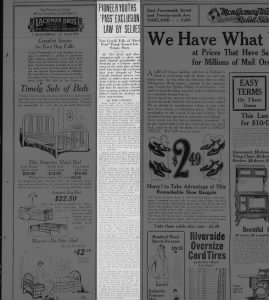 PIONEER YOUTHS 'PASS' EXCLUSION LAW BY SELVES Tom Carroll
17 Jul 1924, Thu
Oakland Tribune (Oakland, California) Newspapers.com
PIONEER YOUTHS 'PASS' EXCLUSION LAW BY SELVES Tom Carroll
17 Jul 1924, Thu
Oakland Tribune (Oakland, California) Newspapers.com
TOM'S father, Wesley, who was very successful as a miner, died in 1884. For
10 years or more Tom conducted a large dairy on the Fruitvale acreage and
met with fair success. He was an only son, and even today there are those
who say he was spoiled by his mother's whims. In the backyard of the Carroll
home on Fruitvale Avenue and East 27th Street, Tom took over a huge barn and
made it into a gymnasium. Adjoining the barn was his "athletic field.” The
makeshift gym even held a swimming pool. Joe Herring, a taxidermist who
lived in a little shed on the Carroll place and used his quarters for
stuffing animals, was also mechanic enough to paper the big barn in good
style. Tom moved in a piano and when the boys tired of athletic activities
they turned to singing and music. It must have been quite a spot. Among the
spectators who were frequently interested was Charles Pratt, the unofficial
"Mayor of Fruitvale." In 1898 they asked Tom to become the constable of
Brooklyn Township, "He later had to campaign for the office and I remember
carrying the paste bucket and posters. Big Tom tagged along behind to tell
me where to place the posters," Ed Kramer says. After Tom took over as
constable he arranged a "drunk cell” in a shed on his place on Fruitvale
Avenue near East 16th Street, Tom never arrested anyone. He'd just pick 'em
up and taken down to the shed and let them sleep until sober. But before we
progress further with Tom and his job as constable we must tell of another
companion that made the Carroll gym his home. This was Duncan Ross, a huge
Scot and a swordsman. Duncan also made the Olympic team with Tom and later
toured England and France. From France came stories of Ross hanging up a pig
by its feet and then, with one giant swipe of his sword, he'd bisect the
pig. Unfortunately, Duncan Ross had a taste for other pursuits than athletic
contests.
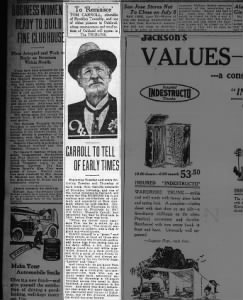 To 'Reminisce' Tom Carroll 29 Jun 1924, Sun
Oakland Tribune (Oakland, California) Newspapers.com
To 'Reminisce' Tom Carroll 29 Jun 1924, Sun
Oakland Tribune (Oakland, California) Newspapers.com
AT THE Carroll gym in the barnyard of the one-time dairy big Tom Carroll
found himself working with such outstanding fighters as
James J. Corbett,
then
Bob Fitzsimmons, and later
Jim Jeffries.
Bob Edgren, well known
newspaper cartoonist, was also a patron as were
Al Plaw, Carl Shattuck,
Jack Merchant and Ralph Rose. These were young men who became famous in
the boxing ring and on track and field teams, Tom's fame spread quickly,
and soon he was aiding
Walter Christie to coach and train field event men
for the University of California. Tom and big Duncan Ross drew quite an
audience when they would "
toss the caber," a sport from the Highland
country of old Scotland. Duncan would also take the role of strong man on
Sundays to earn his spending money.
Fruitvale in those days was dotted with fashionable beer gardens, an attraction for many of San Francisco's
sportsmen and their lady friends. Big Tom and Duncan frequently performed
at
Charles Tepper's place in what is now the
Dimond District. Duncan,
stretched out on two chairs (head on one, feet on the other) would allow a
huge rock to be placed in his midsection. With the beer drinking audience
all agog, big Tom would take a sledge hammer and smash the rock. The
applause was said to have been deafening. In spite of all these colorful
goings-on, big Tom Carroll is probably best remembered today for his
corduroy togs and companion Collie dogs. He always wore corduroy suits,
big boots and a large Stetson hat, and he kept the Collie dogs by his side
wherever he went. Everyone knew him and his dogs. They were Tom Carroll's
trademark.
ONE of Tom Carroll's favorite pastimes in the autumn days of his of the
one-time dairy, big Tom the yesteryears.
[I think the type got mislaid on that last sentence. - MF] One of his
fondest recollections was his first streetcar ride in 1872 on the old
Highland Park and Fruitvale line owned by
E. Sessions. One Sunday it tipped
over and rolled to the bottom of a canyon. Everyone aboard was in their
Sunday best, bound for
Dimond Park. Authorities blamed the accident on a
200-pound woman who flopped down in a seat as the car pulled along the edge
of the canyon. Fortunately, no injuries resulted. "The Dimond District was a
beer-lovers paradise," Tom said. “Here was Charlie Tepper's place,
The Hermitage, The Knecht House,
Bohauffers and Jack Morgan's place. It was at
this latter place on High Street and Plitzville Park that the Norwegian sea
captains and Swedish sailors used to gather.” Another fond memory concerned
Joe Sullivan, the Brooklyn giant. “I believe he was the biggest native son
California ever produced. He was born in Alameda about 1863
[1867] and from that
time spent all his life growing. He tried to find a job to keep out of the
stare of people. When he was 21, Fire Chief James Moffett measured him. He
was eight feet tall, weighed 420 pounds, had 14-1/2-inch wrists, 18-inch
ankles, and spread his arms 8-1/2 feet. He wore No. 17 shoes. Joe was with
Barnum's circus for a long time but tired of traveling and joined the fire
department. Every time a fire occurred the spectators would gather about
Joe, the circus giant.
When Joe died in 1893 a special coffin had to be made
for him. The funeral director arranged for two wagons to haul the casket.”
The Inevitable
THE KNAVE: Time marches on. I was reminded of this cliche at a recent
gathering of the Muir Association at the
Muir Manor in Martinez where
Robin Lampson
gave the memorial address on naturalist
John Muir. All were pleased with
his presentation.
Robin Lampson
operates an art store in Richmond and is the author of several books. I
had known him in his boyhood but had lost track of him in later years. I
rediscovered him only recently. About 40 years ago I was pastor of the
Fair Oaks, Orangevale and Folsom Methodist churches. Later the Folsom
Church was traded for the Orangevale Presbyterian church and combined with
the Methodist congregation there. Today these churches, large and separate
congregations, continue services in beautiful new properties. As a boy of
16 Robin Lampson was a member of my Sunday School in Orangevale. His
mother was a devoted church worker. I am delighted to now find him a
successful businessman and writer. About two years ago I addressed the
Fair Oaks Church Men's Club. It was ladies night and I enjoyed a
delightful evening with them in their new property one mile nearer
Sacramento and really a part of that growing city, I visited the old
church now empty and lonely. The parsonage beside it I built there years
ago. California's population explosion is an amazing thing. But it's
happening elsewhere, too. Two years ago I visited my old home in southern
Indiana along the Ohio River. Even the little town of Guilford a little. A
new Tanners Creek bridge had been built and the old one set aside as a
relic. The old two-story brick school had lost its upper story and is now
a dwelling. The school yard baseball field and the hillside where we
coasted every winter seemed so small. The chimney that we covered with
boards to smoke out the teacher at Halloween had been removed. The only
thing unchanged was Tanners Creek with its long ponds where we would fish
and swim in the summer and skate for miles in the winter. My visit was
interesting but touched with sadness - John W. Winkley
Friends of Bancroft
FRIENDS of the
Bancroft Library will gather at 2:30 p.m. today in Bancroft
Library on the University of California campus, Berkeley. They will hear a
talk by
Paul Mills, curator of the
Oakland Art Museum and an expert in the field of art in
history, a popular writer and noted speaker. Today he will talk on
“California Pictorial History and the
Honeyman Collection.” There will be
a short business meeting, announcement of progress in funding the Honeyman
Collection, an exhibition, and refreshments. The campus parking lot north
of the General Library will be reserved for the use of those attending
today's session ...
The Friends of Bancroft are responsible for
Bancroftiana, a bulletin published occasionally. The April issue of this
bulletin reports that Miss
May Dornin, University Archivist, will retire
June 30 after almost 44 years of service on the Berkeley campus. "Miss
Dornin worked with the university's first Librarian,
J. C. Rowell, in
setting up and classifying the materials of the Archives. In 1946 she was
appointed to head both the Rare Books and Archives Departments, and since
1949 has continued as University Archivist. When the Archives were
transferred to Bancroft Library in 1962 she joined the Bancroft staff as
well," the bulletin reads. "Possessed of a knowledge of the university's
development equalled by few, May Dornin has functioned as unofficial
university historian for many years ... Letters have come to her desk from
all parts of the world with requests for information relating to academic
history and the like, answered only after patient searching for seemingly
unrecorded data ... Her continuing interest in Californiana is explained
in part by her pioneer heritage - her grandfather,
Newton C. Miller,
settled in Grass Valley in 1850, and she hopes to spend some of her time
in examining his papers now housed in the Bancroft Library."
Gifts and Taxes
JULES CHARBNEAU, expert appraiser of fine arts, tells us there'll be some
changes in Uncle Sam's tax laws on June 1 that should concern anyone
contemplating a contribution of art, furniture, fine china, old silver or
similar antiques of historic interest to a museum, college or like
institution. Heretofore the donor could pro-rate the appraised valuation
of such a gift over a 10-year period. They could even continue to keep the
treasure (or contemplated gift) as long as they live, turning it over to
museum or school after their demise. This will hold true only during these
few remaining weeks of May. After June 1, according to Charbneau who
speaks as a senior member of the American Society of Appraisers, the total
appraised valuation of the gift must be taken as a tax deduction in the
year the gift is made. No longer can it be pro-rated. In addition, the
gift must be handed over to the institution at once. Oakland's new Public
Museum now under construction will have wings dedicated to art, history
and nature studies. Now would be the best time to consider contributions,
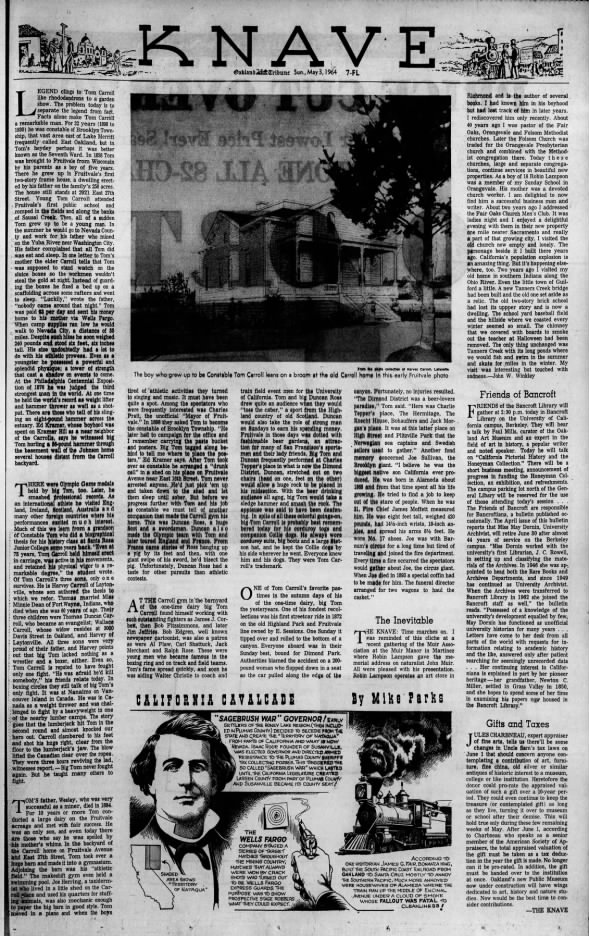 Knave Tom Carroll and Joe Sullivan 03 May 1964, Sun
Oakland Tribune (Oakland, California) Newspapers.com
Knave Tom Carroll and Joe Sullivan 03 May 1964, Sun
Oakland Tribune (Oakland, California) Newspapers.com



 To 'Reminisce' Tom Carroll 29 Jun 1924, Sun
Oakland Tribune (Oakland, California) Newspapers.com
To 'Reminisce' Tom Carroll 29 Jun 1924, Sun
Oakland Tribune (Oakland, California) Newspapers.com


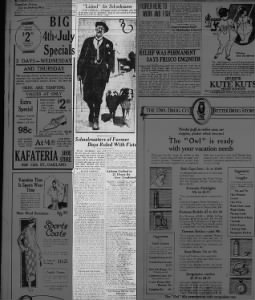
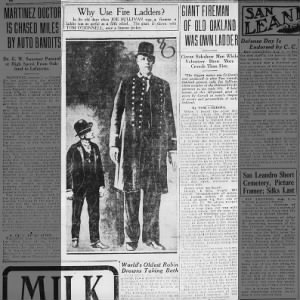


I use to live on Lynde Street and I did a history of Geo. Lynde I remember seeing Carroll on one of the censuses. -https://abitofhistory.site/2019/05/22/george-l-lynde-lynde-street/
ReplyDeleteThank you, Littledots.
ReplyDelete